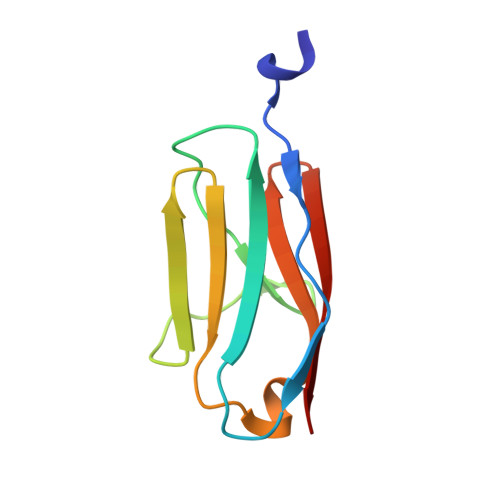Exploration of pathomechanisms triggered by a single-nucleotide polymorphism in titin's I-band: the cardiomyopathy-linked mutation T2580I.
Bogomolovas, J., Fleming, J.R., Anderson, B.R., Williams, R., Lange, S., Simon, B., Khan, M.M., Rudolf, R., Franke, B., Bullard, B., Rigden, D.J., Granzier, H., Labeit, S., Mayans, O.(2016) Open Biol 6
- PubMed: 27683155
- DOI: https://doi.org/10.1098/rsob.160114
- Primary Citation of Related Structures:
5JDD, 5JDE, 5JDJ - PubMed Abstract:
Missense single-nucleotide polymorphisms (mSNPs) in titin are emerging as a main causative factor of heart failure. However, distinguishing between benign and disease-causing mSNPs is a substantial challenge. Here, we research the question of whether a single mSNP in a generic domain of titin can affect heart function as a whole and, if so, how. For this, we studied the mSNP T2850I, seemingly linked to arrhythmogenic right ventricular cardiomyopathy (ARVC). We used structural biology, computational simulations and transgenic muscle in vivo methods to track the effect of the mutation from the molecular to the organismal level. The data show that the T2850I exchange is compatible with the domain three-dimensional fold, but that it strongly destabilizes it. Further, it induces a change in the conformational dynamics of the titin chain that alters its reactivity, causing the formation of aberrant interactions in the sarcomere. Echocardiography of knock-in mice indicated a mild diastolic dysfunction arising from increased myocardial stiffness. In conclusion, our data provide evidence that single mSNPs in titin's I-band can alter overall muscle behaviour. Our suggested mechanisms of disease are the development of non-native sarcomeric interactions and titin instability leading to a reduced I-band compliance. However, understanding the T2850I-induced ARVC pathology mechanistically remains a complex problem and will require a deeper understanding of the sarcomeric context of the titin region affected.
- Department of Integrative Pathophysiology, Medical Faculty Mannheim, Theodor-Kutzer-Ufer 1-3, 68167 Mannheim, Germany Institute of Integrative Biology, University of Liverpool, Crown Street, Liverpool, L69 7ZB, UK.
Organizational Affiliation:

















